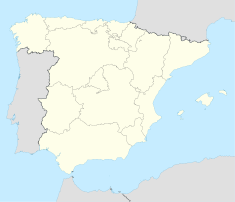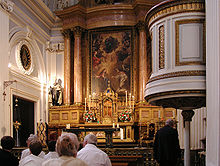- Royal Convent of La Encarnación
-
Royal Monastery of la Encarnación Location: Madrid, Spain Coordinates: 40°25′11″N 3°42′41″W / 40.419807°N 3.711438°WCoordinates: 40°25′11″N 3°42′41″W / 40.419807°N 3.711438°W Spanish Property of Cultural Interest Official name: Real Monasterio de la Encarnación Type: Non-movable Criteria: Monument Designated: 1994[1] Reference #: RI-51-0008767 The Royal Monastery of the Incarnation or Real Monasterio de la Encarnación is a convent of the order of Recolet Augustines located in Madrid, Spain. The institution mainly interned women from noble families, and was founded by the Queen Margaret of Austria, wife of Philip III, and thus was well endowed with wealth. Although it belongs to an enclosed religious order, the building is open to the public under the administration of the Patrimonio Nacional.
History
The impulse for the founding of the monastery by Queen Margaret, and sometimes the nuns are called las Margaritas, was to celebrate her husband's expulsion of the Moriscos, resident Moors. The queen had the prioress of the monastery of discalced nuns of San Agustín in Valladolid, Mother Mariana de San José, accompanied by Francisca de San Ambrosio (sister of the marquesa de Pozas), Catalina de la Encarnación, and Isabel de la Cruz. First lodged in the Convent of Santa Isabel while they awaited the completion, they received donations from the king and queen, including jewels, to finance the monastery. The monastery was built adjacent to the then extant Real Alcázar, and had a passageway to allow the royals direct access. The monastery was inaugurated in the 2nd of July of 1616, a few years after the queen had died.
The architect and friar Alberto de la Madre de Dios designed and built the monastery between 1611-1616. The facade has a sobriety recalling the style of Juan de Herrera. The monastery, now partly a museum, has a wealth of works of art and relics including tubes with the blood of St. Januarius and of St. Pantaleon.
During the reign of Charles IV of Spain, his prime minister, Manuel Godoy, would attend daily mass here, walking from his nearby Palace of Floridablanca. When Joseph Bonaparte entered Madrid as king, a hanged cat was found on the monastery gate with the writing: Si no lías pronto el hato,/ te verás como este gato. ("If you don't leave this town soon/ you'll end up like this cat"). In the 19th century, the composer Lorenzo Román Nielfa was professor of music here. The monastery was open to the public in 1965.
The interior of the church was redecorated in the 18th century, including frescoes in the ceiling of the main chapel by Francisco Bayeu. In the center of the retablor of the main altar is an Annunciation by Vincenzo Carducci. The tabernacle was completed by Ventura Rodríguez. The small statues of the Doctors of the Church and the bas-relief of the Savior are by Isidro Carnicero.
References
- ^ Database of protected buildings (movable and non-movable) of the Ministry of Culture of Spain
External links
Royal sites of the Patrimonio Nacional Royal Palaces 
Monasteries Convent of Las Descalzas Reales · Convent of La Encarnación · Convent of Santa Clara · Abbey of Santa María la Real de Las Huelgas · Valle de los CaídosOther 'Casita del Príncipe · Casita del Infante · Pantheon of Illustrious Men · Convent of San Pascual · Convent of Santa Isabel · Colegio de Doncellas NoblesCategories:- Augustinian nunneries
- 1616 establishments
- Monasteries in Madrid
- Bien de Interés Cultural buildings
Wikimedia Foundation. 2010.





